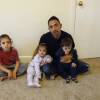Terrified. Disoriented. Desperate. This is how refugees arrive on American shores. Helping them integrate into American society, with all the positive economic and social benefits this brings, inevitably falls to our education system. We must be ready for the task.
Late last year, at a resettlement center in Indiana established by Operation Allies Welcome — an American initiative for supporting displaced Afghans — a woman separated from her family during the messy evacuation of Afghanistan said that the “people of the United States have a heart of gold,” adding that military and diplomatic personnel “behaved very patiently and justly with Afghan people.”
And we have always responded in kind. It has long been in America’s DNA to be generous in helping traumatized people flee dire circumstances, survive, and seek better lives. Humanitarian goodwill remains a defining value for Americans. A September 2021 NPR/Ipsos poll showed that 7 in 10 favor resettling Afghans who worked with the U.S. government or military. There is always more to do: as we endeavor to resettle Afghan refugees, there are thousands of Haitians knocking at the door at the Southern Border.
Once admitted, as a nation we are still learning how to help refugees thrive. Can we be better at sustained welcomes — that is, at understanding what it takes to fully integrate into a diverse, democratic society?
Recently, I participated in a White House roundtable discussion highlighting the efforts of the Welcome Campus Network, an affiliated grouping of higher education institutions working to provide scholarships, housing, sponsorship and pathways to education for Afghan refugees.
We took the long view. Because being a refugee is about being unmoored from anything and everything that has given life meaning — one’s home, country, family life and dreams. The trauma doesn’t go away once refugees have reached safety. It lingers over a lifetime.
Emotional and mental health challenges, for example, can metastasize into longer-term roadblocks like slower English-language acquisition, haunting trauma and blocked socioeconomic mobility.
That is why community partners in the initivate to support Afghan refugees — many led by former refugees themselves — are calling on us to provide more and better supports than those offered to previous waves of refugees, particularly in education.
If we are going to welcome Afghan refugees effectively, here are four considerations:
- Stop seeing refugee and immigrant students as kids who simply don’t know English. This narrow focus misses the incredible resilience newcomers bring with them — as well as the social-emotional, cultural, structural and legal barriers they face in navigating a new country.
- Provide professional development to all school staff in serving immigrant and refugee students. They are our students, not just the responsibility of one or two faculty in a building. And we need not reinvent the wheel: there are exemplary schools already serving immigrant and refugee students.
- Bridge the gap between newcomers, their peers and the communities in which they settle. One way to do that is our Moving Stories project in which students, faculty and community members interview each other about their migration experiences.
- Teach the great migration journeys in the curriculum. Migration is the throughline of human experience, yet the way it is taught is frequently mired in myths and misconceptions that get in the way of helping students understand current events.
Our research suggests that refugee children are uniquely resilient in the face of challenges like forced displacement. Education can help them draw on that resilience, opening pathways for growth, development and intercultural competence.
More than any other institution in American society, schools will play a critical role in the day-to-day integration of newly arrived Afghan youth. They will join some 27% of students in our K-12 schools who have an immigrant parent.
And despite already being overburdened and underfunded, public education is a wise investment. One day, these young people will be our engineers, computer scientists, first responders, entrepreneurs, doctors and police officers.
Schools are places of learning and enculturation for newly arrived students and spaces that can bind young people together. America’s economic and social future requires all of us to be able to work and live with people whose identities, accents, experiences, cultures and ideas are different from our own.
While it is gratifying to see the warm welcome communities are offering to Afghan youths, ultimately, it is the follow-through that matters most. Schools are where kids are integrated into society. Indeed, the road to full integration for Afghanis shouldn’t end with a few months of generous gestures. Ideally, the road never ends. It is paved with understanding and empathy and girded with institutional support. It leads to stable, thriving permanent immigrant communities where there is equity, a keen sense of belonging, civility and systemic dignity for all. And it arrives at a place people can once again call home.
Our American welcome is best sustained through education.
Marcelo M. Suárez-Orozco is Chancellor at the University of Massachusetts, Boston and the UCLA Wasserman Dean Emeritus. His forthcoming volume is Education: A Global Compact for a Time of Crisis.







